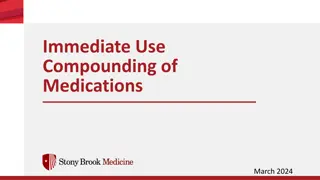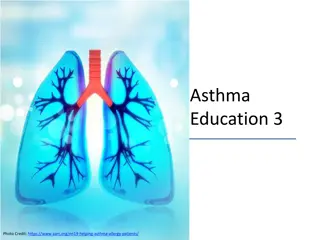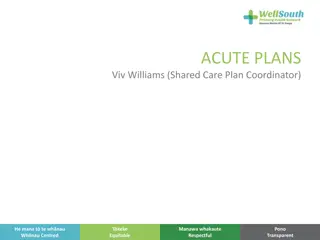Medications in Acute Care: Impact on Physical Therapy
Side effects of medications in the acute setting can manifest as impairments in various body systems, including integumentary, musculoskeletal, cardiovascular/pulmonary, and neuromuscular systems. Factors influencing adverse drug events include pharmacokinetics, drug interactions, and patient-specific characteristics. Common potential drug side effects range from mild symptoms like constipation and nausea to more severe issues such as confusion and weakness, impacting activities like falls and cognitive function. Specific drug categories, like those affecting the heart and circulation or anti-hypertensive medications, have distinct effects and considerations in the acute care setting.
Download Presentation

Please find below an Image/Link to download the presentation.
The content on the website is provided AS IS for your information and personal use only. It may not be sold, licensed, or shared on other websites without obtaining consent from the author. Download presentation by click this link. If you encounter any issues during the download, it is possible that the publisher has removed the file from their server.
E N D
Presentation Transcript
Common Medications in the Acute Setting & Their Impact on Physical Therapy Beverly Knight PHYT 764 In-service UNC DPT 2014
Side effects of medications can present as an impairment of the integumentary, musculoskeletal, cardiovascular/pulmonary, or neuromuscular system. 1
Risk Factors for Adverse Drug Events (ADE s)1 Pharmacokinetics ADE s Drug-drug interaction Drug-disease interaction
Risk Factors for Adverse Drug Events (ADE s) Age (over 65) Sex Small physical size or stature Hyperpharmacotherapy Polypharmacy Prescribing cascade History of ADE s Racial and ethnic variations
Potential Drug Side Effects1: Side effects: predictable pharmacologic effects that occur within therapeutic dose ranges and are undesirable in the given therapeutic situation. Most common SE s: constipation or diarrhea, nausea, abdominal pain and sedation More severe SE s: confusion, drowsiness, weakness, and loss of coordination Adverse events: falls, anorexia, fatigue, cognitive impairment, urinary incontinence and constipation.
Medicines and Falls in the Hospital Mechanisms leading to a fall is one or more of: Sedation Hypotension Bradycardia, tachycardia or periods of asystole
So lets talk about specific medications and drug categories ..
Drugs acting of the heart & circulation: Maintaining consciousness and an upright posture requires adequate blood flow to the brain. Requires a pulse and blood pressure BP of 110mmHg or below in older adults
Anti-hypertensive drugs: Beta Blockers: High BP -olol (Atenolol, sotalol, bisoprolol, timolol) SE s: Bradycardia, hypotension, orthostatic hypotension, vasovagal syndrome ACE Inhibitors High BP and CHF -pril (lisopril, enalapril, etc.) -SE s: low BP, dizziness, headache, drowsiness, weakness4
Digoxin Antidysrhrthmic drug used to treat CHF and atrial fibrillation. Oral or injection drug May cause bradycardia and other arrhythmias2 , visual disturbances4 SE s:are dose dependent The usual starting dose is 0.0625-0.25 mg daily depending on age and kidney function.
Non-Steroidal Anti-inflammatory Drugs (NSAIDs) Purpose: to treat inflammation; analgesics SE s: stomach upset and pain Among surgical pts can cause postoperative complications, such as wound hematoma, upper GI tract bleeding, hypotension, and impaired bone or tendon healing.1
NSAIDS continued. May cause increased blood pressure and peripheral edema Renal complications Myocardial event Confusion and memory loss in the older adult
Acetaminophen Uses: Pain reliever, fever reducer SE s: not common,4most severe is liver damage Dosing: for adults is 325 to 650 mg every 4 hours or 500 mg every 8 hours when using immediate release formulations. Max daily dose of 4 grams.
Opioids Uses: to treat mild to moderately severe pain Codeine, morphine, tramadol, hydrocodone, oxycodone, hydromorphone (Diladid) SE s: headache, nausea, constipation, dry mouth, impaired balance, drowsiness or dizziness..........
Opioids continued. Sedation, slow reactions, impaired balance, delirium.2 Adverse Events: increase the risk of falls. High risk: can commonly cause falls alone or in combination
Coumadin (Warfarin)4 Warfarin is an oral anticoagulant, a drug that inhibits the clotting of blood. Uses: DVT, post-MI, TKA/THA, reduce risk of PE and stroke. Dosing: starts at 2-5mg 1x/daily and adjusted based on INR. SE s: The two most serious side effects are bleeding and necrosis (gangrene) of the skin (bleeding can occur in any organ or tissue).
Heparin Uses: prevent and treat blood clots Injection into vein or subcutaneously Dosage: based on your medical condition, weight, and response to treatment.4 SE s: bleeding, thrombocytopenia (HIT or HITT), pain, severe headache, dizziness, Rare SE s: pain/loss of feeling in arms/legs, chest pain, trouble breathing, confusion, weakness on one side of body, vision changes.
Lovenox (Enoxaparin) Anticoagulant Low molecular weight heparin (LMWH) Dosing: administered by injection under the skin (subcutaneous) or intravenously. Dose varies SE s: bleeding, anemia, thrombocytopenia, fever, diarrhea, fluid retention,
Minocycline Uses: treats a variety of bacterial infections; build up of fluid around the lungs (pleural effusion). SE s: nausea, vomiting,diarrhea, lightheadedness,dizziness, unsteadiness, drowsiness, vertigo, ataxia. 3,4 Injection or oral medication Dose: 2x daily every 12 hours (venous injection)
Implication for PT: Side effects: weakness, dizziness, impaired coordination, drowsiness, nausea, anemia, etc. Adverse Events: FALLS, fatigue, constipation. Vitals Safety!!!
Clinical Pearls:1 Older adults taking NSAIDS and antihypertensive agents must be monitored carefully. Regardless of the NSAID chosen, it is important to check blood pressure when exercise is initiated and periodically afterwards. The therapist may be the first one to recognize a problem with medication or dosage. Bringing this to the attention to the doctor is a valuable service to the client.
Resources: Epocrates online MedicineNet Medscape
References 1. Goodman, C., and T. Snyder. "Differential diagnosis for physical therapists."Screening for referral. Missouri: Saunders Elsevier (2007). 2. Dwight, Jeremy. "Medicines and Falls in Hospital: Guidance Sheet. 3. Epocrates Online: An Athenahealth Company. Available at: https://online.epocrates.com/noFrame/. Accessed April 16, 2013. 4. MedicineNet: We Bring Doctor s Knowledge to You. Available at: http://www.medicinenet.com/script/main/hp.asp. Accessed April 16, 2013.























